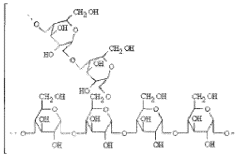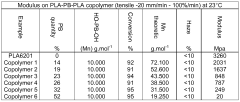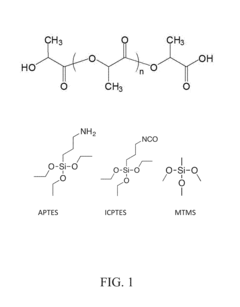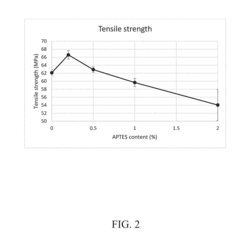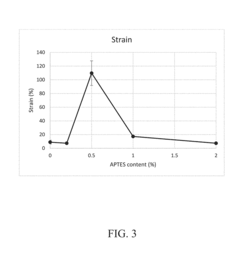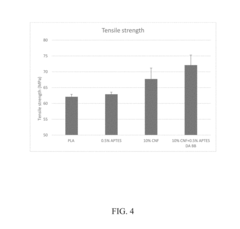How to Reduce PLA Brittleness with Advanced Techniques?
JUN 25, 20259 MIN READ
Generate Your Research Report Instantly with AI Agent
Patsnap Eureka helps you evaluate technical feasibility & market potential.
PLA Brittleness Background and Objectives
Polylactic acid (PLA) has emerged as a prominent biodegradable polymer in recent years, gaining significant attention due to its eco-friendly properties and versatile applications. However, the inherent brittleness of PLA has been a persistent challenge, limiting its widespread adoption in various industries. This technical report aims to explore advanced techniques for reducing PLA brittleness, addressing the evolving landscape of polymer science and materials engineering.
The development of PLA as a sustainable alternative to petroleum-based plastics has been driven by growing environmental concerns and the need for renewable resources. Since its commercial introduction in the 1990s, PLA has undergone continuous improvements in production processes and material properties. The primary goal of this research is to overcome the brittleness issue while maintaining PLA's desirable characteristics, such as biodegradability and biocompatibility.
PLA brittleness is attributed to its high glass transition temperature, low crystallization rate, and poor chain mobility. These factors contribute to its limited elongation at break and low impact strength, which restrict its use in applications requiring toughness and flexibility. The objective of this investigation is to identify and evaluate advanced techniques that can effectively enhance PLA's ductility and impact resistance without compromising its biodegradability or other beneficial properties.
Recent technological advancements have opened up new possibilities for modifying PLA's molecular structure and improving its mechanical properties. These include novel copolymerization methods, blending with other biodegradable polymers, and the incorporation of nanofillers. Additionally, innovative processing techniques such as reactive extrusion and stereocomplexation have shown promise in altering PLA's crystallization behavior and enhancing its overall performance.
The evolution of PLA technology has been marked by significant milestones, including the development of high-molecular-weight PLA, stereocomplex PLA, and various PLA-based composites. These advancements have expanded the potential applications of PLA across diverse sectors, including packaging, automotive, and biomedical industries. However, the persistent challenge of brittleness continues to drive research efforts towards more sophisticated solutions.
As we delve into the current state of PLA technology and explore emerging trends, this report will provide a comprehensive overview of the most promising approaches to reducing PLA brittleness. By examining the underlying principles, experimental results, and potential scalability of these techniques, we aim to identify pathways for future development and innovation in this critical area of polymer science.
The development of PLA as a sustainable alternative to petroleum-based plastics has been driven by growing environmental concerns and the need for renewable resources. Since its commercial introduction in the 1990s, PLA has undergone continuous improvements in production processes and material properties. The primary goal of this research is to overcome the brittleness issue while maintaining PLA's desirable characteristics, such as biodegradability and biocompatibility.
PLA brittleness is attributed to its high glass transition temperature, low crystallization rate, and poor chain mobility. These factors contribute to its limited elongation at break and low impact strength, which restrict its use in applications requiring toughness and flexibility. The objective of this investigation is to identify and evaluate advanced techniques that can effectively enhance PLA's ductility and impact resistance without compromising its biodegradability or other beneficial properties.
Recent technological advancements have opened up new possibilities for modifying PLA's molecular structure and improving its mechanical properties. These include novel copolymerization methods, blending with other biodegradable polymers, and the incorporation of nanofillers. Additionally, innovative processing techniques such as reactive extrusion and stereocomplexation have shown promise in altering PLA's crystallization behavior and enhancing its overall performance.
The evolution of PLA technology has been marked by significant milestones, including the development of high-molecular-weight PLA, stereocomplex PLA, and various PLA-based composites. These advancements have expanded the potential applications of PLA across diverse sectors, including packaging, automotive, and biomedical industries. However, the persistent challenge of brittleness continues to drive research efforts towards more sophisticated solutions.
As we delve into the current state of PLA technology and explore emerging trends, this report will provide a comprehensive overview of the most promising approaches to reducing PLA brittleness. By examining the underlying principles, experimental results, and potential scalability of these techniques, we aim to identify pathways for future development and innovation in this critical area of polymer science.
Market Analysis for Improved PLA Materials
The market for improved PLA materials is experiencing significant growth, driven by the increasing demand for sustainable and biodegradable plastics across various industries. PLA (Polylactic Acid) has gained popularity as an eco-friendly alternative to traditional petroleum-based plastics, but its inherent brittleness has limited its widespread adoption in certain applications. This has created a substantial market opportunity for advanced PLA materials with enhanced mechanical properties, particularly reduced brittleness.
The global bioplastics market, of which PLA is a key component, is projected to grow at a compound annual growth rate (CAGR) of over 10% in the coming years. This growth is fueled by stringent environmental regulations, consumer awareness of plastic pollution, and corporate sustainability initiatives. The packaging industry remains the largest consumer of PLA, accounting for a significant portion of the market share, followed by the automotive, electronics, and medical sectors.
In the packaging industry, there is a growing demand for PLA materials that can withstand higher temperatures and exhibit improved impact resistance. This is particularly important for food packaging applications, where the material needs to maintain its integrity during transportation and storage. The automotive sector is also showing increased interest in PLA-based composites for interior components, driven by the need for lightweight, sustainable materials that meet stringent performance requirements.
The medical industry represents another promising market for improved PLA materials. With its biocompatibility and biodegradability, PLA is already used in various medical applications such as sutures and implants. However, the development of PLA materials with reduced brittleness could expand its use in more demanding medical devices and tissue engineering scaffolds.
Geographically, North America and Europe are currently the largest markets for improved PLA materials, due to strict environmental regulations and high consumer awareness. However, the Asia-Pacific region is expected to witness the fastest growth in the coming years, driven by rapid industrialization, increasing environmental concerns, and government initiatives promoting sustainable materials.
Key market players in the improved PLA materials space include established chemical companies and specialized bioplastics manufacturers. These companies are investing heavily in research and development to overcome PLA's limitations and expand its application range. Collaborations between material scientists, polymer engineers, and end-users are becoming increasingly common, fostering innovation in PLA formulations and processing techniques.
The market analysis reveals that while there is strong demand for improved PLA materials, challenges remain in terms of cost competitiveness with traditional plastics and achieving consistent performance across various applications. However, as production scales up and technologies advance, the price gap is expected to narrow, further driving market growth for enhanced PLA materials.
The global bioplastics market, of which PLA is a key component, is projected to grow at a compound annual growth rate (CAGR) of over 10% in the coming years. This growth is fueled by stringent environmental regulations, consumer awareness of plastic pollution, and corporate sustainability initiatives. The packaging industry remains the largest consumer of PLA, accounting for a significant portion of the market share, followed by the automotive, electronics, and medical sectors.
In the packaging industry, there is a growing demand for PLA materials that can withstand higher temperatures and exhibit improved impact resistance. This is particularly important for food packaging applications, where the material needs to maintain its integrity during transportation and storage. The automotive sector is also showing increased interest in PLA-based composites for interior components, driven by the need for lightweight, sustainable materials that meet stringent performance requirements.
The medical industry represents another promising market for improved PLA materials. With its biocompatibility and biodegradability, PLA is already used in various medical applications such as sutures and implants. However, the development of PLA materials with reduced brittleness could expand its use in more demanding medical devices and tissue engineering scaffolds.
Geographically, North America and Europe are currently the largest markets for improved PLA materials, due to strict environmental regulations and high consumer awareness. However, the Asia-Pacific region is expected to witness the fastest growth in the coming years, driven by rapid industrialization, increasing environmental concerns, and government initiatives promoting sustainable materials.
Key market players in the improved PLA materials space include established chemical companies and specialized bioplastics manufacturers. These companies are investing heavily in research and development to overcome PLA's limitations and expand its application range. Collaborations between material scientists, polymer engineers, and end-users are becoming increasingly common, fostering innovation in PLA formulations and processing techniques.
The market analysis reveals that while there is strong demand for improved PLA materials, challenges remain in terms of cost competitiveness with traditional plastics and achieving consistent performance across various applications. However, as production scales up and technologies advance, the price gap is expected to narrow, further driving market growth for enhanced PLA materials.
Current Challenges in PLA Toughness Enhancement
Polylactic acid (PLA) has gained significant attention as a biodegradable and renewable alternative to traditional petroleum-based plastics. However, its inherent brittleness remains a major obstacle for widespread adoption in various applications. The current challenges in PLA toughness enhancement are multifaceted and require innovative solutions to overcome.
One of the primary challenges is the limited molecular weight of PLA, which directly affects its mechanical properties. The relatively low molecular weight results in reduced entanglement density and poor chain mobility, contributing to its brittle nature. Increasing the molecular weight through improved polymerization techniques or post-processing methods is crucial but faces difficulties in maintaining processability and avoiding thermal degradation.
Another significant challenge lies in the crystallization behavior of PLA. The slow crystallization rate and low crystallinity of PLA contribute to its brittleness. Enhancing the crystallization kinetics and controlling the crystal morphology are essential for improving toughness. However, achieving a balance between increased crystallinity and maintaining other desirable properties, such as transparency and biodegradability, remains a complex task.
The glass transition temperature (Tg) of PLA is another critical factor affecting its brittleness. With a Tg around 60°C, PLA exhibits brittle behavior at room temperature. Lowering the Tg to improve chain mobility and enhance ductility is desirable, but it often comes at the cost of reduced thermal stability and mechanical strength.
Incorporating toughening agents, such as plasticizers or impact modifiers, is a common approach to enhance PLA's toughness. However, finding compatible additives that do not compromise other properties, such as biodegradability or food contact compliance, poses a significant challenge. Additionally, achieving a uniform dispersion of these additives within the PLA matrix without phase separation or migration is crucial for long-term performance.
The development of effective blending and compatibilization strategies for PLA with other polymers is another area of focus. While blending can potentially improve toughness, issues such as poor interfacial adhesion, phase separation, and maintaining biodegradability of the final product present ongoing challenges.
Lastly, the scalability and cost-effectiveness of toughness enhancement techniques remain significant hurdles. Many laboratory-scale solutions face difficulties in translation to industrial-scale production, either due to complex processing requirements or prohibitive costs. Developing economically viable and easily implementable methods for large-scale production of toughened PLA is crucial for its widespread adoption in various applications.
One of the primary challenges is the limited molecular weight of PLA, which directly affects its mechanical properties. The relatively low molecular weight results in reduced entanglement density and poor chain mobility, contributing to its brittle nature. Increasing the molecular weight through improved polymerization techniques or post-processing methods is crucial but faces difficulties in maintaining processability and avoiding thermal degradation.
Another significant challenge lies in the crystallization behavior of PLA. The slow crystallization rate and low crystallinity of PLA contribute to its brittleness. Enhancing the crystallization kinetics and controlling the crystal morphology are essential for improving toughness. However, achieving a balance between increased crystallinity and maintaining other desirable properties, such as transparency and biodegradability, remains a complex task.
The glass transition temperature (Tg) of PLA is another critical factor affecting its brittleness. With a Tg around 60°C, PLA exhibits brittle behavior at room temperature. Lowering the Tg to improve chain mobility and enhance ductility is desirable, but it often comes at the cost of reduced thermal stability and mechanical strength.
Incorporating toughening agents, such as plasticizers or impact modifiers, is a common approach to enhance PLA's toughness. However, finding compatible additives that do not compromise other properties, such as biodegradability or food contact compliance, poses a significant challenge. Additionally, achieving a uniform dispersion of these additives within the PLA matrix without phase separation or migration is crucial for long-term performance.
The development of effective blending and compatibilization strategies for PLA with other polymers is another area of focus. While blending can potentially improve toughness, issues such as poor interfacial adhesion, phase separation, and maintaining biodegradability of the final product present ongoing challenges.
Lastly, the scalability and cost-effectiveness of toughness enhancement techniques remain significant hurdles. Many laboratory-scale solutions face difficulties in translation to industrial-scale production, either due to complex processing requirements or prohibitive costs. Developing economically viable and easily implementable methods for large-scale production of toughened PLA is crucial for its widespread adoption in various applications.
Existing PLA Toughening Solutions
01 Blending with other polymers
Blending PLA with other polymers can improve its brittleness. This approach involves mixing PLA with flexible or tough polymers to enhance its mechanical properties. The resulting blend can have improved impact strength and elongation at break, addressing the brittleness issue of pure PLA.- Blending with other polymers: Blending PLA with other polymers can improve its brittleness. This approach involves mixing PLA with flexible or tough polymers to enhance its mechanical properties. The resulting blend often exhibits improved ductility and impact resistance while maintaining some of PLA's desirable characteristics.
- Addition of plasticizers: Incorporating plasticizers into PLA can reduce its brittleness. Plasticizers work by increasing the free volume between polymer chains, enhancing their mobility and flexibility. This results in a more ductile material with improved elongation at break and impact strength.
- Modification of crystallinity: Controlling the crystallinity of PLA can affect its brittleness. By adjusting processing conditions or using nucleating agents, the degree of crystallinity can be optimized. This can lead to a balance between stiffness and toughness, potentially reducing brittleness while maintaining other desirable properties.
- Surface treatment and coating: Applying surface treatments or coatings to PLA products can improve their resistance to brittle fracture. These treatments can modify the surface properties of PLA, potentially enhancing its durability and reducing the likelihood of crack initiation and propagation.
- Nanocomposite formation: Incorporating nanoparticles or nanofibers into PLA can create nanocomposites with improved mechanical properties. These nanofillers can enhance the strength and toughness of PLA, potentially reducing its brittleness while also improving other characteristics such as barrier properties or thermal stability.
02 Addition of plasticizers
Incorporating plasticizers into PLA can increase its flexibility and reduce brittleness. Plasticizers work by increasing the free volume between polymer chains, allowing for greater molecular mobility. This results in a more ductile material with improved impact resistance and elongation properties.Expand Specific Solutions03 Copolymerization with other monomers
Copolymerizing PLA with other monomers can modify its molecular structure and improve its mechanical properties. This approach allows for the incorporation of flexible segments into the PLA backbone, resulting in a copolymer with reduced brittleness and enhanced toughness.Expand Specific Solutions04 Incorporation of nanofillers
Adding nanofillers to PLA can enhance its mechanical properties and reduce brittleness. Nanofillers, such as nanoclay or carbon nanotubes, can improve the strength and toughness of PLA by acting as reinforcing agents and creating a more complex network structure within the polymer matrix.Expand Specific Solutions05 Modification of processing conditions
Optimizing processing conditions during PLA manufacturing can help reduce its brittleness. This includes controlling parameters such as temperature, cooling rate, and crystallization conditions. Proper processing can lead to improved molecular orientation and crystallinity, resulting in a tougher and less brittle PLA material.Expand Specific Solutions
Key Players in PLA Research and Development
The market for reducing PLA brittleness is in a growth phase, driven by increasing demand for sustainable plastics. The global bioplastics market, including PLA, is projected to reach $19.93 billion by 2026, with a CAGR of 13.8%. Technological maturity varies among key players. Companies like LG Chem, BASF, and 3M Innovative Properties are at the forefront, leveraging their extensive R&D capabilities. Academic institutions such as Sichuan University and the University of Michigan are contributing significant research. Emerging players like Arctic Biomaterials and Newlight Technologies are introducing innovative solutions. The competition is intensifying as both established chemical companies and specialized bioplastics firms invest in advanced techniques to enhance PLA properties.
LG Chem Ltd.
Technical Solution: LG Chem has developed a proprietary technology called "Impact Modifier" to reduce PLA brittleness. This technique involves blending PLA with specially designed elastomeric particles that enhance the material's impact resistance and flexibility. The company has also implemented a controlled crystallization process that improves the heat resistance and durability of PLA without compromising its biodegradability. Additionally, LG Chem has explored the use of chain extenders to increase the molecular weight of PLA, resulting in improved mechanical properties and reduced brittleness.
Strengths: Improved impact resistance and flexibility; Enhanced heat resistance; Maintained biodegradability. Weaknesses: Potential increase in production costs; May affect transparency of PLA.
Far Eastern New Century Corp.
Technical Solution: Far Eastern New Century has developed a multi-phase blending technique to reduce PLA brittleness. This approach involves creating a polymer blend of PLA with other biodegradable polymers such as PBAT (polybutylene adipate terephthalate) or PBS (polybutylene succinate). The company has optimized the blending ratios and processing conditions to achieve a balance between improved toughness and maintained biodegradability. They have also incorporated nano-reinforcements, such as cellulose nanocrystals, to further enhance the mechanical properties of the PLA-based blends.
Strengths: Significantly improved toughness and flexibility; Maintained biodegradability; Enhanced thermal stability. Weaknesses: Potential reduction in tensile strength; Increased complexity in material formulation and processing.
Innovative Approaches to PLA Modification
Polymer composition
PatentWO2014202481A1
Innovation
- A composition comprising polylactic acid (PLA), polybutadiene (PB), and a block copolymer of PLA and PB, which acts as a compatibilizer to enhance impact resistance and stability by improving the miscibility and compatibility of the polymers.
Silane-modified polyester blends and methods of preparation
PatentActiveUS20190062495A1
Innovation
- Development of silane-modified polyester blends with silane molecules containing two or three alkoxy groups, which are homogeneously blended with PLA, achieving a combination of exceptional ductility and toughness through in situ formation of nanoscale PLA-silane architecture.
Environmental Impact of PLA Modifications
The environmental impact of PLA modifications aimed at reducing brittleness is a crucial consideration in the development of advanced techniques. While PLA is inherently biodegradable, alterations to its composition may affect its eco-friendly properties. The addition of plasticizers, for instance, can potentially introduce non-biodegradable elements into the material, compromising its end-of-life decomposition. However, some modifications, such as the incorporation of natural fibers or biobased additives, may enhance both mechanical properties and environmental sustainability.
The use of nanocomposites to improve PLA's toughness presents a complex environmental scenario. While these additives can significantly enhance material performance, their potential release into ecosystems during degradation raises concerns about nanoparticle accumulation in the environment. Careful selection of nanofillers and thorough lifecycle assessments are essential to mitigate these risks.
Blending PLA with other biodegradable polymers to reduce brittleness can maintain or even improve the overall biodegradability of the resulting material. However, the environmental impact of producing these additional polymers must be factored into the overall ecological footprint of the modified PLA. Energy consumption and greenhouse gas emissions associated with the production of these blends may offset some of the environmental benefits of PLA.
Chemical modifications, such as copolymerization or chain extension, can alter PLA's degradation profile. While these techniques can effectively reduce brittleness, they may also slow down the material's biodegradation rate. This trade-off between improved mechanical properties and extended environmental persistence requires careful optimization to ensure that the modified PLA still meets biodegradability standards.
The processing methods used to implement these modifications also have environmental implications. Advanced techniques like reactive extrusion or in-situ polymerization may require additional energy inputs or chemical catalysts, potentially increasing the carbon footprint of PLA production. However, if these processes result in more durable PLA products with longer lifespans, the overall environmental impact could be positive due to reduced material consumption and waste generation over time.
Recycling considerations are another critical aspect of the environmental impact of modified PLA. Some modifications may complicate existing PLA recycling processes, potentially reducing the material's recyclability. Developing compatible recycling technologies for modified PLA is crucial to maintaining its circular economy potential and minimizing landfill waste.
In conclusion, while advanced techniques to reduce PLA brittleness offer significant potential for expanding its applications, their environmental impact must be carefully evaluated. A holistic approach considering the entire lifecycle of modified PLA, from raw material sourcing to end-of-life management, is essential to ensure that improvements in material properties do not come at the cost of environmental sustainability.
The use of nanocomposites to improve PLA's toughness presents a complex environmental scenario. While these additives can significantly enhance material performance, their potential release into ecosystems during degradation raises concerns about nanoparticle accumulation in the environment. Careful selection of nanofillers and thorough lifecycle assessments are essential to mitigate these risks.
Blending PLA with other biodegradable polymers to reduce brittleness can maintain or even improve the overall biodegradability of the resulting material. However, the environmental impact of producing these additional polymers must be factored into the overall ecological footprint of the modified PLA. Energy consumption and greenhouse gas emissions associated with the production of these blends may offset some of the environmental benefits of PLA.
Chemical modifications, such as copolymerization or chain extension, can alter PLA's degradation profile. While these techniques can effectively reduce brittleness, they may also slow down the material's biodegradation rate. This trade-off between improved mechanical properties and extended environmental persistence requires careful optimization to ensure that the modified PLA still meets biodegradability standards.
The processing methods used to implement these modifications also have environmental implications. Advanced techniques like reactive extrusion or in-situ polymerization may require additional energy inputs or chemical catalysts, potentially increasing the carbon footprint of PLA production. However, if these processes result in more durable PLA products with longer lifespans, the overall environmental impact could be positive due to reduced material consumption and waste generation over time.
Recycling considerations are another critical aspect of the environmental impact of modified PLA. Some modifications may complicate existing PLA recycling processes, potentially reducing the material's recyclability. Developing compatible recycling technologies for modified PLA is crucial to maintaining its circular economy potential and minimizing landfill waste.
In conclusion, while advanced techniques to reduce PLA brittleness offer significant potential for expanding its applications, their environmental impact must be carefully evaluated. A holistic approach considering the entire lifecycle of modified PLA, from raw material sourcing to end-of-life management, is essential to ensure that improvements in material properties do not come at the cost of environmental sustainability.
Scalability of Advanced PLA Toughening Methods
The scalability of advanced PLA toughening methods is a critical factor in determining their practical applicability and potential for widespread adoption in various industries. As researchers and manufacturers continue to develop innovative techniques to enhance PLA's toughness, it is essential to evaluate the scalability of these methods to ensure their viability in large-scale production environments.
One of the primary considerations in scaling up PLA toughening techniques is the compatibility with existing manufacturing processes. Methods that can be easily integrated into current production lines without significant modifications or additional equipment are more likely to be adopted by industry players. For instance, melt blending with other polymers or adding plasticizers can often be implemented using standard extrusion or injection molding equipment, making these approaches highly scalable.
Another aspect of scalability is the availability and cost of materials used in toughening processes. Techniques that rely on readily available and cost-effective additives or modifiers are more likely to be scalable. For example, the use of natural fibers or minerals as reinforcing agents can be advantageous due to their abundance and relatively low cost. However, more specialized additives or nanoparticles may face challenges in large-scale production due to limited availability or high costs.
The consistency and reproducibility of toughening effects across different production batches and scales are crucial factors in determining scalability. Methods that demonstrate robust and predictable improvements in PLA toughness, regardless of production volume, are more likely to be adopted for industrial applications. This requires thorough testing and optimization of process parameters to ensure consistent results in large-scale production environments.
Environmental considerations also play a role in the scalability of PLA toughening methods. Techniques that maintain or enhance PLA's biodegradability and eco-friendly characteristics are more likely to be scalable in the long term, as they align with the growing demand for sustainable materials. Methods that introduce non-biodegradable components or significantly alter PLA's end-of-life properties may face regulatory and market acceptance challenges, limiting their scalability.
The energy and resource requirements of toughening processes are important factors in assessing scalability. Methods that can achieve desired toughness improvements with minimal energy input and resource consumption are more likely to be economically viable at larger scales. This includes considerations such as processing temperatures, reaction times, and the need for specialized equipment or controlled environments.
In conclusion, the scalability of advanced PLA toughening methods depends on a complex interplay of factors, including process compatibility, material availability, consistency of results, environmental impact, and resource efficiency. As research in this field progresses, it is crucial to consider these aspects to develop toughening techniques that are not only effective but also practical for large-scale industrial applications.
One of the primary considerations in scaling up PLA toughening techniques is the compatibility with existing manufacturing processes. Methods that can be easily integrated into current production lines without significant modifications or additional equipment are more likely to be adopted by industry players. For instance, melt blending with other polymers or adding plasticizers can often be implemented using standard extrusion or injection molding equipment, making these approaches highly scalable.
Another aspect of scalability is the availability and cost of materials used in toughening processes. Techniques that rely on readily available and cost-effective additives or modifiers are more likely to be scalable. For example, the use of natural fibers or minerals as reinforcing agents can be advantageous due to their abundance and relatively low cost. However, more specialized additives or nanoparticles may face challenges in large-scale production due to limited availability or high costs.
The consistency and reproducibility of toughening effects across different production batches and scales are crucial factors in determining scalability. Methods that demonstrate robust and predictable improvements in PLA toughness, regardless of production volume, are more likely to be adopted for industrial applications. This requires thorough testing and optimization of process parameters to ensure consistent results in large-scale production environments.
Environmental considerations also play a role in the scalability of PLA toughening methods. Techniques that maintain or enhance PLA's biodegradability and eco-friendly characteristics are more likely to be scalable in the long term, as they align with the growing demand for sustainable materials. Methods that introduce non-biodegradable components or significantly alter PLA's end-of-life properties may face regulatory and market acceptance challenges, limiting their scalability.
The energy and resource requirements of toughening processes are important factors in assessing scalability. Methods that can achieve desired toughness improvements with minimal energy input and resource consumption are more likely to be economically viable at larger scales. This includes considerations such as processing temperatures, reaction times, and the need for specialized equipment or controlled environments.
In conclusion, the scalability of advanced PLA toughening methods depends on a complex interplay of factors, including process compatibility, material availability, consistency of results, environmental impact, and resource efficiency. As research in this field progresses, it is crucial to consider these aspects to develop toughening techniques that are not only effective but also practical for large-scale industrial applications.
Unlock deeper insights with Patsnap Eureka Quick Research — get a full tech report to explore trends and direct your research. Try now!
Generate Your Research Report Instantly with AI Agent
Supercharge your innovation with Patsnap Eureka AI Agent Platform!

